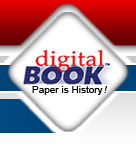 |
 |
 |
||||||||||
 |
|
|
 |
|||||||||
 |
 |
|||||||||||
 |
Profile |
2024 DigitalBook, Inc |
 |
|||||||||
 |
 |
|||||||||||

PAPER IS HISTORY
The history of the Digital Book begins in the mid ‘80s when the poet and writer Zahur Klemath Zapata had a vision of a book opened before him, on the screen of a computer which he had not yet even purchased. Zahur maintains that this mental picture clarified to him one of the maxims of Albert Einstein which says that imagination is more important than knowledge. At this time Zahur knew little about computers, less about the programs which are their nervous system, and less still of the intrinsic complexity of their design.
Ten years later [1995 ], Zahur would bring to market the first digital books at ‘The Eighth International Book Fair’ in Bogotá, Colombia. The first title published in the digital book format was ‘Murder as One of the Fine Arts'. This was soon followed by books from popular authors such as Kafka, Faust, Goethe and Cervantes.
As is expected when a new products is born that has significant market expectation, large industrial companions throughout the world express interest, and pulse their machinations, till a new market is created. Soon a tide is born, and digital books become widely available. The largest companies in their respective fields lead the parade to the international level in trying to dominate this nascent market. So this digital book is continuously elevated in exposure by the software companies which market the programs enabling the reading of a book on a computer screen. Appropriately, such programs are called ‘readers’. However, these Goliaths of the software industry are soon to be slain by a David: interestingly, by the same man [Zahur] who founded the digital book concept some two decades earlier. With his latest Digital book tm version 3.0, a new strength and flexibility has been released in the market.
In the years lapsed from 1995 to present, Zahurk has orchestrated a group of programs from the United States, Colombia and Pakistan creating three programs superior to any before them. These three Programs: IDBMS TM, DigitalBook Publisher TM, and Digital Book TM Reader will offer the user the greatest flexibility in designing and reading digital books.
Features will include the turning of pages in the same screen, full color images, sound, and the ability to print pages with the layout conceived by the user. So we are at the doorway to a revolution. Publishing, bookselling, even the ubiquitous public library; these will never again be as in times past. Indeed we are moving toward becoming a paperless society, PAPER IS HISTORY
 |
 |
||||||||
 |
|
 |
|||||||
 |
 |